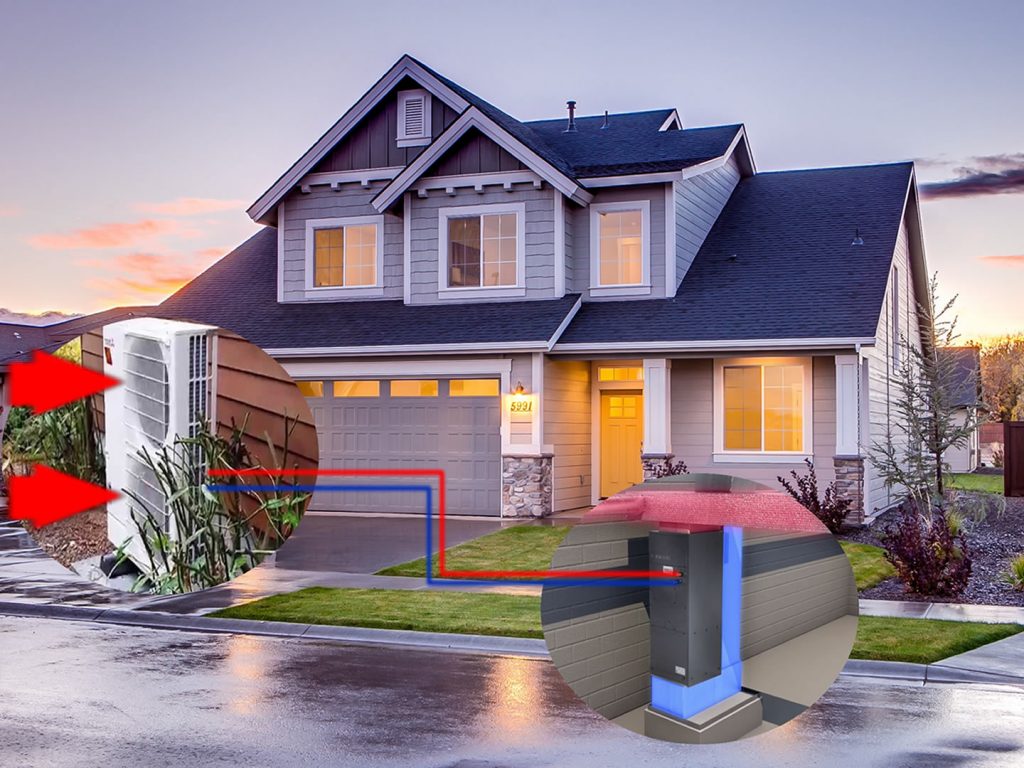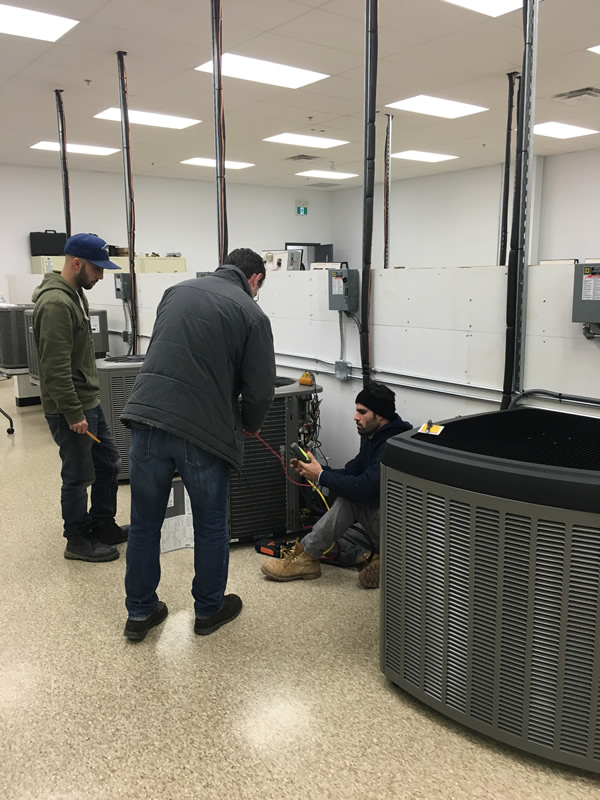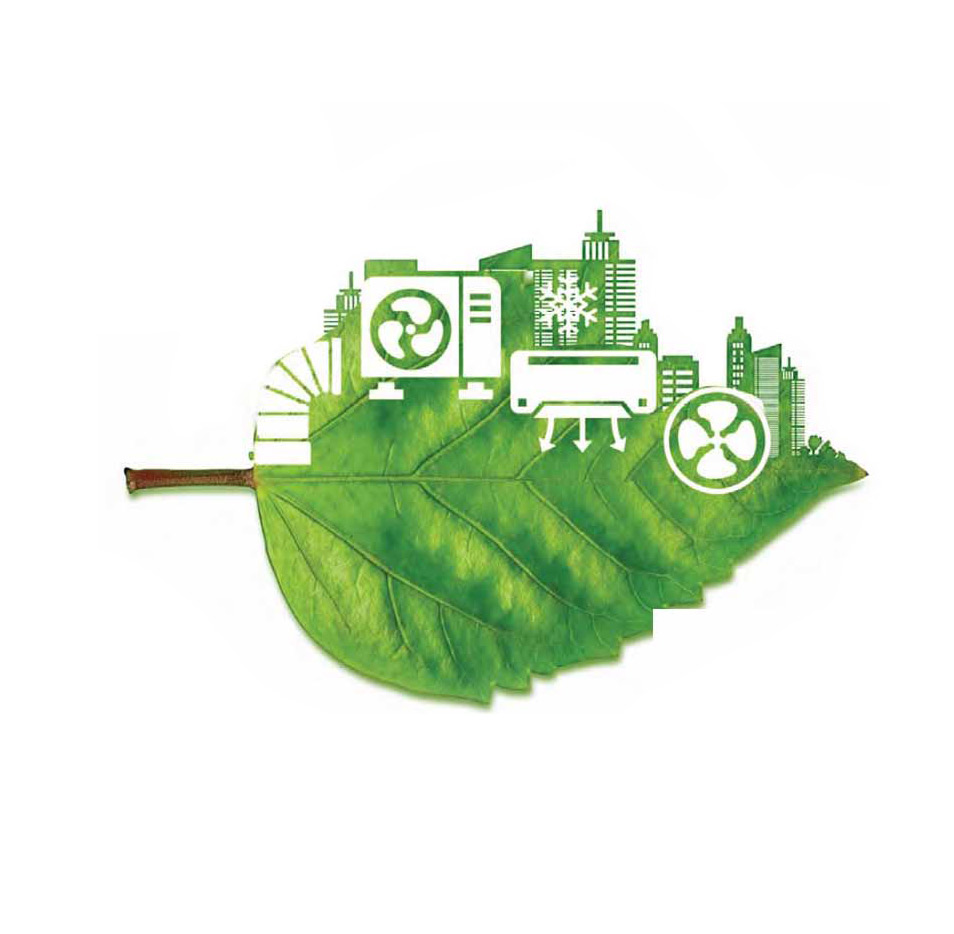
Air Source Heat Pumps are electric heating and cooling devices that extract heat from the air and transfer it either inside or outside your home. Heat pumps are essentially advanced Air Conditioners that are able to completely reverse their function and efficiently generate heat in your home during the cold winter months. Where an air conditioner is designed to only extract heat from your home and replace it with cool air, a heat pump is capable of both. Heat pumps have been available for decades, however only in the past 10-15 years have more advanced units been engineered that are suitable for use in cold northern climates. Now that these technologies are available, heat pumps can be utilized far more widely then ever before. Dual fuel systems that include the highest efficiency gas furnaces paired with low ambient heat pumps are becoming increasingly more popular in urban centers.
During the warm summer months, Air Source Heat Pumps work in cooling mode. They completely reverse their function and remove warm air from your home. They are very efficient at cooling and in many cases provide better cooling performance than standard air conditioners.
Many Heat pump systems are equipped with Inverter compressors or variable speed air handlers that will provide your home with only the necessary amount of heating and cooling required. As opposed to traditional on/off style compressors or motors that will cycle 100% on and then off allowing for much greater temperature swings in your home.
Air source heat pumps have been proven to reduce electricity consumption by up to 50% and in some cases even more. They are the perfect alternative to electric resistance heating. Heat Pumps also have the added bonus of high performance air conditioning.
These systems will help reduce the cost of heating with oil or propane and will drastically reduce the cost of heating with electric resistance, like baseboard or electric furnaces. The air they produce is more moist and a humidifier is not required, where as with a gas furnace you will need a humidifier. Heat pumps also have “green” benefits, as they do not pollute the environment. Other systems such as oil furnaces naturally produce more pollution during combustion.
This is data collected by Hydro One that effectively illustrates the operating costs of a high performance air source heat pump vs. electric resistance heating. Our experience with these systems back up these conclusions. We have seen in some circumstances where savings have exceeded 60%.

A properly installed heat pump will provide you heating and cooling comfort for years after installation. However, a heat pump is a far more complex machine and requires very experienced professionals to install them. Many air conditioning technicians will claim they can properly install a heat pump, we have seen the result of these claims. There are installation practices that a highly trained, experienced heat pump technician will use that allows the unit to operate at its peak efficiency. Ensuring your installation is done correctly will drastically reduce costly repair calls and unexpected system down time.
At Imperial Energy we employ highly trained and experienced technicians. We successfully install over 100 new heat pump systems each year and that number is rapidly increasing. Check out how other people are Going Green Here
Air Purification is the process by which we remove, destroy or render harmless bio-aerosols and volatile organic compounds in the air we breathe. Filters are used mostly to remove inert particulate from the air stream. Unfortunately, this accounts for on average only 35% of our indoor air quality problem. Microscopic gases and bio-aerosols are the real danger and can only be addressed by other means. Air purification is the single most important defense in reducing harmful contaminants within our homes and places of work, especially in the absence of any outside air exchange.
Efficiently operating down to -15C. Ducted low ambient units can be installed and used as a primary heating source or a supplementary heating source. Used as a supplementary heating source these units will help reduce costly oil and propane consumption, also achieving a lowered carbon footprint. They have been proven to work very well as a primary heating source in condo’s and town homes with all electric central air. Savings have proven to be up to 60% vs. electric resistance only heating systems. When temperatures do become too cold for the heat pump to provide the necessary heating, auxiliary heating sources are installed. Advanced high efficiency gas furnaces with A.F.U.E. ratings up to 98% are often used as an auxiliary source for the home.
Cold Climate Certified Heat Pumps can be ducted and ductless solutions designed to operate in very low outside temperatures. Some products are available that can efficiently heat down to -30C or below before any supplementary heating is required. These units are incredibly efficient and can produce winter operating costs comparable to natural gas heat sources. Cold Climate Certified systems are engineered for operation in cold northern climates. They use advanced technologies allowing them to extract heat from very cold air. These systems are an effective alternative to geothermal, oil and propane heating. If propane is your backup fuel source, hydronic heating coils pair very nicely with these systems.
Heat flows naturally from a higher to a lower temperature. Heat pumps however, are able to force the heat flow in the other direction, using a relatively small amount of high quality drive energy (electricity, fuel, or high temperature waste heat). Thus heat pumps can transfer heat from natural heat sources in their surroundings such as the air, ground or water, or even man-made heat sources such as industrial or domestic waste, to a building or an industrial application.
Heat pumps can also be used for cooling. During the cooling process heat is transferred in the opposite direction, from the application that is cooled to surroundings at a higher temperature. Sometimes the excess heat from cooling is used to meet a simultaneous heat demand.
During the heating cycle, a heat pump will remove heat and humidity from the outdoor air and will transfer this heat to your home. This is possible because even at zero degrees Fahrenheit, outdoor air contains a great deal of heat. Remember that your heat pump doesn’t generate much heat, but rather transfers it from one place to another.
Heat pumps are also more efficient because they use renewable energy in the form of low-temperature heat.
A heat pump delivers a lower supply air temperature than a furnace over a longer period of time to provide a more constant heat. It may give you the impression that your system “never stops running”, or “it feels like cold air”. At times, the temperature of the air coming out of the vents is less than your body temperature so it feels like cold air. But it is still providing heat for your house. And when it can no longer keep-up with the heat loss of the structure, the 2nd stage or auxiliary heat will automatically energize, bringing on a much warmer heat.
During the heating cycle, you may notice water running off the outdoor coil. Moisture from the air is condensed on the outside surface of the coil where it gathers and runs off. This is completely normal.
At certain conditions (low temperature, high humidity), frost and even ice may build up on the coil of the outdoor unit. In order to maintain heating efficiency the system will automatically defrost itself. Steam rising form the outdoor unit is normal and is and indication of proper operation. The vapor cloud will only last for a few minutes. When the defrost cycle is completed, the system will automatically switch back to heating. Supplemental heat is automatically energized to maintain comfort during defrost.
During the heating season a heat pump sometimes makes a “whooshing” sound and you may feel cool air coming from the supply registers. This is normal. In fact, it’s generally a sign that your heat pump is working exactly as it should.
The “whooshing” sound you hear is made by a valve as it reverses your unit from the heating mode to the defrost mode. It’s like your unit is briefly switching over from heating to air conditioning. This way the heat gets directed towards the outdoors, melting the ice on the heat exchangers instead of going into your house. As a result, cold air comes in through your supply registers rather than warm air.
Once the ice is gone, the heat pump will switch automatically back into heating mode. You shouldn’t turn your heat pump off from the thermostat while defrost mode is engaged. It will only delay the removal of the ice. Not only does the ice build-up make your heat pump less efficient, if it’s not defrosted promptly it can cause damage to the unit.
In addition to the whooshing noise and the cold air, when your heat pump is defrosting you may see steam rising from it or water running off. Again, these are both normal parts of the defrost cycle. The temperature in your home may drop a few degrees as well. But don’t worry—your heat pump is doing what it’s supposed to do. You’ll be warm and cozy again within no time!
It can vary, depending on how much the system is used and how regularly it is checked or serviced. Generally, the average life-span of units built in the 1970s and 1980s is about 15 years, but individual units may vary and last much longer depending on use and how well they are maintained. An ARI survey showed average heat pump life to be about 14 years when recommended maintenance procedures were followed. Newer units are expected to last even longer.
When the system starts giving you more problems that are not cost-effective to fixing it might be time for a new heat pump. If the unit is approaching 10 years in age and major components such as the compressor, reversing valve, accumulator or outdoor coil go bad, it might make sense to replace the entire unit instead of fix your current one. Replacing a compressor for example is somewhat less expensive than replacing the entire unit, but new units may give you greater efficiency. A new unit will also give you lower operating costs and a brand new warranty on the entire unit, not just the part needed to be replaced. When faced with major repairs, we can help you make the right choice.
The ductwork in your home is already sized for a specific amount of air volume, so a larger heat pump would need larger ductwork. Severely over sizing heat pumps can cause many performance problems, like poor cooling and general irritations such as excessive noise. A slightly larger heat pump (provided your system can accommodate it) can be installed to increase heating output allowing you to utilize the heat pump more at colder temperatures. Using multi-stage or variable speed compressors with larger indoor coils help achieve this. These will allow greater control of air speed and output. Sizing really needs to be carefully considered to give you maximum performance and must be assessed by a site visit or an engineers heating and cooling load calculation.
This is not something you will need to do yourself. A properly installed heat pump system will be configured to complete this operation on its own.
Standard one-inch air filters should be checked every month during peak use, and replaced if it looks dirty enough to impair the air flowing through it. Some filters, such as electrostatic filters or electronic air cleaners, are washable. Others such as media type air cleaners are disposable and must be replaced, though many of those filters are designed to last up to six months and possibly even a year.
You cannot cover the outdoor unit. It runs during the winter and cannot operate if the unit is covered.
Check out our green HVAC resources to learn more about different models and the best green energy solutions for your household heating and cooling systems.

Copyright 2023 Imperial Energy | All Rights Reserved
Powered by Imperial Energy